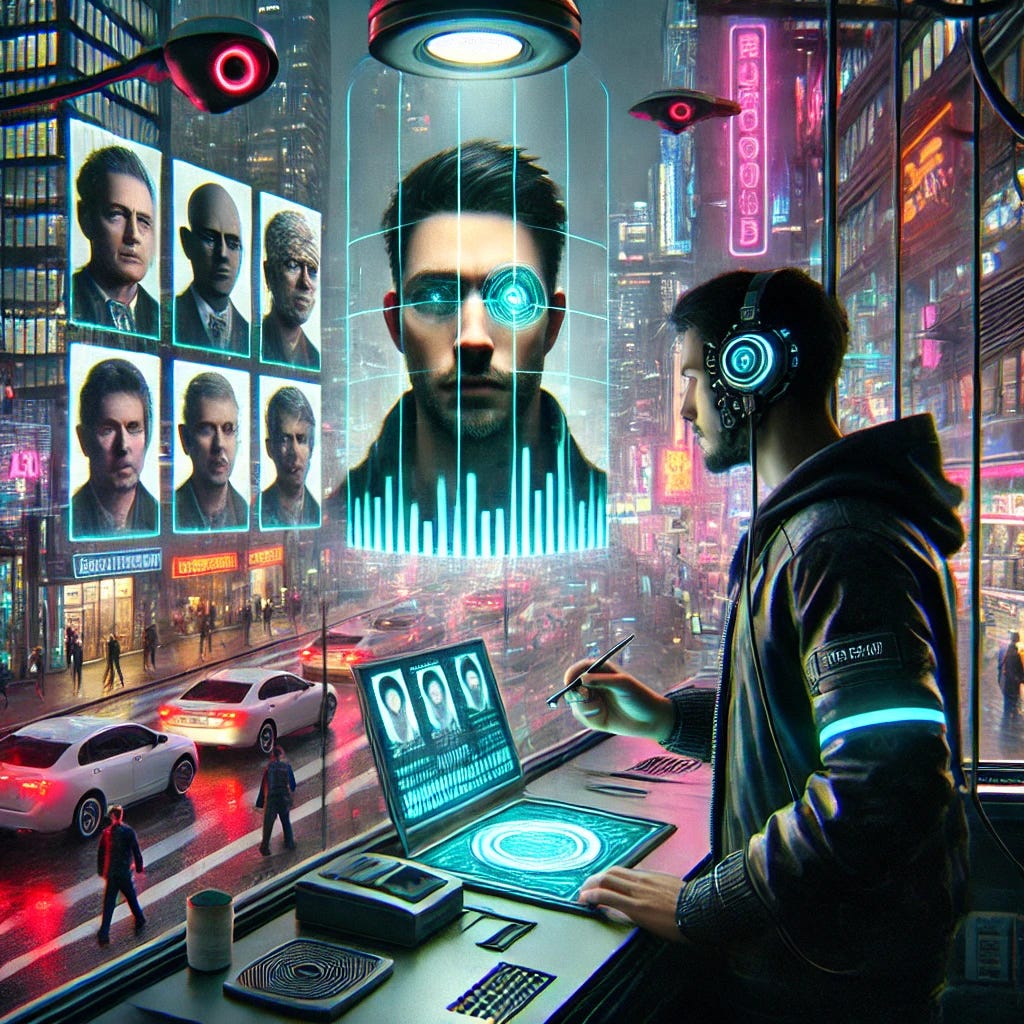Down Man
New York has always been a city haunted by its ghosts, and its skyline is a living memory of tragedies that shaped the nation.
On September 11, 2001, the world watched in horror as the Twin Towers collapsed. But for New Yorkers, one image became seared into their collective consciousness: the Falling Man—a lone figure plummeting through the sky, an unspeakable choice captured in a single, haunting photograph.
Fifty years later, on September 11, 2051, history repeated itself. Another attack, this time on One World Trade Center, sent shockwaves through the city. Explosions gutted the tower, and in the chaos, men and women leapt from skyscrapers, their silhouettes hauntingly familiar.
New York fell into a depression unlike anything before.
Lower Manhattan—once the beating heart of global finance and resilience—became something else entirely: a monument to loss, fear, and the fragile nature of human control. The survivors, left to rebuild in the ashes of another catastrophe, gave the district a new name: Down Man.
It was more than a geographical marker.
It was an elegy.
A reminder of the weight of gravity—both physical and historical. The place where men fell, and where hope never fully rose again.
By the 2070s, Down Man had become something else: a shadow city, a place where the forgotten gathered, where the system’s grip loosened just enough for humanity’s frayed edges to reappear. It was a place of refuge for the unpredictable, the nonconforming, the lost and the ungoverned. A lawless labyrinth of ruined skyscrapers, neon-lit alleyways, underground clubs, and defiant whispers.
Irides
Irides was grown, not born—one of the Test Tube Generation of the late 2050s, engineered by a society that had long since declared nature too erratic, too prone to deviation. His parent, a high-ranking cognitive scientist, had sculpted his genome with meticulous precision, embedding within him the latest neural interface—a mind chip designed to optimize cognition, regulate emotion, and ensure his trajectory aligned with the rigid architecture of progress.
His path was determined before he had even taken his first breath.
Yet something had gone wrong.
Or perhaps, something had gone right.
Somewhere in his early teens, the chip was altered—whether by a whisper of rogue code, a glitch in the sequencing, or an act of rebellion by an unseen hand. Whatever the cause, its effect was undeniable. The programming that was meant to mold him into an architect of the system instead unlocked something unpredictable—improvisation, intuition, sound.
While his peers streamlined their minds for efficiency, Irides heard rhythm in the circuits, melody in the data streams, music in the cold, controlled world around him.
By the time he was eighteen, he had vanished from the sterile corridors of the research enclaves. He reappeared in the decaying skeleton of Down Man—a place where the last remnants of human unpredictability still thrived.
There, he became something the system had never intended.
Not just a musician, but an underground legend in Down Man’s neon-lit ruins.
His hands wove across retro-electro keyboards, bending quantum-synced loops into something raw, something human. His music pulsed through the underground clubs like a heartbeat in the dark, a defiant sound against the silence of compliance.
But the city outside those neon sanctuaries was changing. The Compliance Acts had turned identity into a prison, and Big Other watched from every glowing screen, every drone’s unblinking eye.
Then came the night Irides was shot.
He had only stepped outside for air—a small, thoughtless act. But the streets of Down Man were not the streets of old New York. They had become something else—hyper-zoned districts where movement itself was a privilege.
A Sentinel Drone hovered down from the sodium-lit haze, scanning him with the cold precision of an unfeeling algorithm. It should have cleared him. But it hesitated.
Some buried line of code—some decision made beyond human hands—labeled Irides, the synth-musician, as an anomaly.
And then, without warning, it fired.
The shot seared through his side, a glancing burn. But it wasn’t the wound that changed him—it was what it did to the chip in his head.
A catastrophic malfunction. A reboot.
Irides fell to the ground convulsing, his vision fracturing into lines of code, the world around him reduced to raw data. A flood of information poured into his mind—architectures of surveillance networks, security firewalls, identity registries. The music that had once been his only refuge was gone, replaced by something sharper, something deeper.
Patterns. Systems. The invisible threads that held society in its rigid shape.
When he awoke days later, his hands no longer moved the same way. The dexterity that had once let him dance across synth boards had been shattered. The music had left him. But in its place, something new had emerged.
A gift. A curse. A path.
He no longer heard melodies in the circuits. He saw them.
The architecture of control, the latticework of surveillance—he could read them as if they were compositions.
And in this forced rebirth, he discovered the Chameleon Code.
The mind chip, once a leash, had become a gateway. The forced reboot had unlocked layers of encryption, hidden capabilities buried deep in its neural mesh. Irides saw the flaw in the system—the loophole they had overlooked in their arrogance.
As defined by the state, identity was nothing more than a dataset, a series of coordinates in a shifting digital landscape. It was not real.
And what is not real can be rewritten.
Through the underground networks of Down Man, Irides began to experiment. He developed the first iteration of Chameleon Tech—a protocol that could rewrite a person’s biometric signature in real time. Facial recognition scanners, retinal scans, and gait analysis could all be overridden or changed, like shifting frequencies in a song.
He tested it first on himself.
The results were undeniable.
One moment, he was Irides, the musician who had been branded an anomaly. The next, he was an unremarkable worker, passing through security checkpoints unnoticed. Then he was an old man. Then a woman. Then someone who had never existed at all.
The music had left him, but now, he was playing a different instrument.
A new kind of revolution.
A war fought not with weapons, but with identity itself.
He no longer needed to run.
He could simply become someone else.
The Chameleon Uprising
By 2084, Big Other had transformed the world into a digital feudal state. Every citizen was tracked, categorized, assigned a place in the machine. But Chameleon Tech had changed the game.
Irides had become more than a man—he was a myth, a ghost in the system. They had tried to erase him before, but how do you erase someone who can become anyone?
And now, he stood before the crowd in Fallen Towers Park, his holographic projection towering above them. The glow reflected in their eager eyes, flickering like the last embers of a dying firestorm.
“Big Other has divided us for too long,” he declared. “They have sold us fear, broken our unity, and told us to accept our fate. No more.”
He activated the Chameleon App. His appearance shifted—White, Black, old, young, male, female, something in between. Every iteration of identity flickered before them. The crowd gasped, then roared.
“We are no longer prisoners of identity,” he said. “We are Chameleons. And we will not be othered.”
The march began, surging through Down Man like a tidal wave. The unseen, the forgotten, the discarded—now visible, undeniable, unstoppable.
But as they reached Plutopia Plaza, the trap was sprung.
The riot police moved in, faceless in their unmarked armor. Surveillance drones circled overhead, their sensors calibrating. The corporate news anchors’ voices echoed from the towering screens above:
“The so-called Chameleon uprising has reached Plutopia Plaza. Authorities have identified its leader as Jabari Okoro, a fugitive hacker wanted for cyber crimes against the state.”
The system’s final weapon.
A lie.
An erasure.
Surveillance is not about security. It is about control.
And control is not about force. It is about perception.
Big Other perfected its greatest weapon for decades—not violence, but the illusion of truth. It did not need to crush revolutions with brute force. It only needed to convince people they had never begun in the first place.
This was how they dismantled Chameleon.
This was how they turned identity against itself.
But Chameleon’s strength—its fluidity, its ability to transform—was also its weakness.
If identity could be anything, then identity could also be nothing.
Big Other understood this. And so they played the ultimate shell game.
They manufactured a past for Irides.
They named him Jabari Okoro—a fabricated criminal, a digital phantom inserted into the system’s records. They constructed a paper trail that had never existed before, filling it with just enough truth to make the lie irresistible.
A low-level hacker. A fugitive with a history of cyber crimes. A radical seeking anarchy, not liberation.
And when they revealed this "truth" to the world, they did not attack Irides directly.
They attacked his followers.
They planted the seed of doubt.
And the momentum stalled.
Not because the people feared the authorities.
But because they feared the possibility that they had been deceived.
They had built their movement on the idea that identity was fluid, that it was a choice, that no single name or face defined them. But now, that very philosophy had been twisted into a weapon against them.
If Irides could be anyone…
If names were nothing more than illusions…
Then what proof did they have that their leader—their myth, their hero—had not been a lie all along?
Big Other had turned Chameleon’s own ideology against itself.
This was not a new trick. The machine had always operated this way.
In a world where every face was scanned, where every movement was tracked, the ones who controlled identity controlled reality itself.
They had erased people before—not by making them disappear, but by replacing them.
They had turned radicals into criminals.
They had turned truth-tellers into conspiracy theorists.
They had turned history into a flickering mirage, shifting at their command.
Now, they used the same tactic to break Chameleon from within.
They did not need to kill Irides.
They only needed his followers to question him.
Because once the seed of doubt is planted, once the movement begins fighting itself, the battle is already lost.
This was Big Other’s great irony—that for all of Irides’ efforts to make identity free, it was the system that had mastered its fluidity.
And so, the crowd wavered.
The unity they had built, the revolution they had dreamed of—it all began to crack.
Was Irides their liberator?
Or was he just another mask?
Revolution does not die when the enemy attacks from the outside.
It dies when the people start questioning whether they were ever fighting the right war.
He stepped forward, standing beneath the blinding holographic screens. His voice rang out, defiant:
"This is their lie. They use my past to bury our future."
But the machine had already set its plan in motion.
The first flashbang exploded.
The storm collapsed into chaos.
end of part one
© Michael Arturo, 2025
“Down Man 2084” was featured as Top in Fiction’s selected short series
Please consider sponsoring this content, follow the link below to leave a donation
Buy Me A Coffee
Support by hitting the like button or leaving a comment.
Welcome to Michael’s Newsletter. Writer of contemporary political/social commentary, parodies, parables, satire. Michael was born and raised in New York City and has a background in theater and film. His plays have been staged in New York, London, Boston, and Los Angeles.
Michael also writes short literary fiction. Below is a link to his first collection.



















Share this post